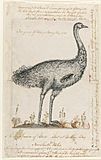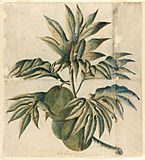Arthur Bowes Smyth facts for kids
Quick facts for kids
Arthur Bowes Smyth
|
|
|---|---|

Arthur Bowes Smyth - Title page of his journal
|
|
| Born | 23 August 1750 Tolleshunt D'Arcy, Essex, England
|
| Died | 31 March 1790 (aged 39) Tolleshunt D'Arcy, Essex, England
|
| Occupation | Surgeon |
| Known for | Surgeon on Lady Penrhyn, diarist and natural history artist |
| Parent(s) | Thomas Smyth (surgeon) and Mary Smyth |
Arthur Bowes Smyth (born 23 August 1750, died 31 March 1790) was a doctor who worked on ships. He sailed on the Lady Penrhyn as part of the First Fleet. This was the first group of ships that sailed to New South Wales to start a new settlement in Australia. Arthur Bowes Smyth kept a detailed diary and drew pictures of the plants and animals he saw in Australia.
Arthur Bowes Smyth's Early Life
Arthur Bowes Smyth was born on 23 August 1750 in a place called Tolleshunt D'Arcy in Essex, England. He was one of ten children. His father, Thomas Smyth, was also a surgeon. Arthur followed in his father's footsteps and worked as a doctor in his hometown.
In 1787, he was chosen to be the "Surgeon to the Ship's Company" on the Lady Penrhyn. This ship was part of the First Fleet. Even though he worked as a surgeon for many years, we don't have records of his official medical qualifications. People think "Surgeon" might have been an honorary title. He was known for helping with childbirth in his local area. This experience was very useful when he looked after the women on the Lady Penrhyn.
His Journal on the Lady Penrhyn
Arthur Bowes Smyth got on board the Lady Penrhyn on 22 March 1787. The ship was about to leave Portsmouth for New South Wales. He became the main doctor for the women on the ship. The first doctor, John Turnpenny Altree, became sick. Governor Arthur Phillip felt that Altree wasn't doing a good job.
Arthur Bowes Smyth, or just Bowes as he was known, kept a journal from 22 March 1787 to 12 August 1789. His journal is a very detailed record of the long journey. He wrote about the weather, what happened on the ship, and how he treated sick people. He also described the places they stopped, like Rio de Janeiro and Cape Town.
His journal is special because he was very interested in nature. He wrote about the birds he saw at Port Jackson and Lord Howe Island. He also drew 25 pictures using watercolour and ink. One of these drawings is the earliest known picture of an emu made by a European. These unique drawings and notes make his journal different from others from the First Fleet.
Bowes Smyth's journal gives us one of the most detailed eyewitness accounts of the first few weeks of European settlement in Australia. His entries from 18 to 26 January describe his first thoughts when they arrived. He wrote about meeting Aboriginal people and what the plants, intense heat, and local animals were like.
The journal also lists the names of the women and children who got off the Lady Penrhyn at Port Jackson. His very first entry on 22 March 1787 lists the full crew. It also lists the women, their age, job, what they were sent for, and how long they were to stay. There are some small mistakes in the list of children born during the trip, like their gender or birth/death dates.
The Lady Penrhyn was hired by the British East India Company to continue its journey to China. It was going to pick up a cargo of tea. The ship left Port Jackson in early May. Bowes Smyth's journal continues, describing the return trip. They went via Lord Howe Island, Tahiti, China, St Helena, and finally back to England.
The original journal is now kept at the National Library of Australia. You can view it online because it has been made into a digital copy. Other copies are held at the British Library and the State Library of New South Wales. The 24 drawings from the copy at the State Library of New South Wales have been separated. They are also available online. The full text of the journal has also been put online. The journal was first published as a book in 1979.
See also
- Journals of the First Fleet





